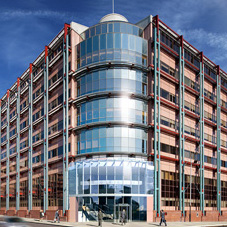Big response to Travel Survey
Published: 5 September 2014
The results of the Tay House relocation travel survey suggest there will be a slight reduction in the number of staff using a car to get to work. Options are now being worked up
The results of the Tay House relocation travel survey suggest there will be a slight reduction in the number of staff using a car to get to work at the new location.
 More than three quarters of the University staff being asked to relocate to the city centre completed the survey, conducted independently for the University by SKM: 190 people out of a total of 220. (Approximately 86%.)
More than three quarters of the University staff being asked to relocate to the city centre completed the survey, conducted independently for the University by SKM: 190 people out of a total of 220. (Approximately 86%.)
SKM say the turnout was an excellent result and means that the survey findings are representative of the current commuting patterns.
The results were discussed earlier this week (2 September) at a meeting of senior University Managers, including those from teams relocating to Tay House; the Move Leads from the departments relocating were also present.
Inter Campus Travel
Unsurprisingly the main mode of travel for journeys to the Gilmorehill Campus for those staff relocating to Tay House is by car, with a total of 58% of respondents driving; 48% drive alone and a further 10% with passengers. Whilst the main mode of travel is by car, 12% travel on foot and 12% travel by public bus. Of the respondents who drive to work, 72% use parking places within the University using a University parking permit. About a third of those who completed the survey said their job meant travelling between campuses.
16% of the staff members completing the survey either walk or cycle to work.
When asked how they expected to travel to Tay House following the relocation, the majority of staff (46%) said they planned to drive to Tay House either alone or with a passenger; this is a slight reduction on those that currently drive to Gilmorehill. 21% of staff are planning to travel by train to Tay House which is an increase of 14% from the current 7% who travel by train to Gilmorehill.
When asked if they expected to travel to the Gilmorehill campus following the relocation, 65% of staff responded in the affirmative. Very few staff are expecting to drive between Tay House and Gilmorehill with the high frequency modes being taxi, university vehicle and bicycle.
Objectives
The meeting to discuss the results of the travel survey debated and agreed the core objectives to be met as decisions on transport and travel (one of the six work streams) are taken in the weeks ahead:
- Ensure that staff relocating to Tay House are able to access their work destination at the time required for their operational commitment whilst minimising personal impact.
- Ensure that staff relocating to Tay House are able to interact, communicate and operate effectively and efficiently with staff and students based at other University locations.
- Ensure that the ongoing and recurring costs to staff associated with their journey to and from Tay House following the relocation to Tay House are minimised.
- Ensure that the ongoing and recurring costs to the university associated with intercampus travel between Tay House and Gilmorehill following the relocation to Tay House are minimised.
SKM will now score the twelve short-listed travel solutions against the objectives outlined above. At the Steering Group meeting scheduled for the 17th September, the outcome of this analysis will be presented. Those travel options deemed most suitable will be grouped into different schemes, and the Steering Group will be asked to decide upon which schemes should then be subjected to a detailed cost analysis. The results of this cost analysis should be available by the end of September.
You can read the summary of the SKM travel survey here:
Tay House Travel Survey Overview
You can also read how the Tay House transport and travel options align with the University's wider travel plan:
Link to the University’s strategic travel plan: 2010/15
First published: 5 September 2014

